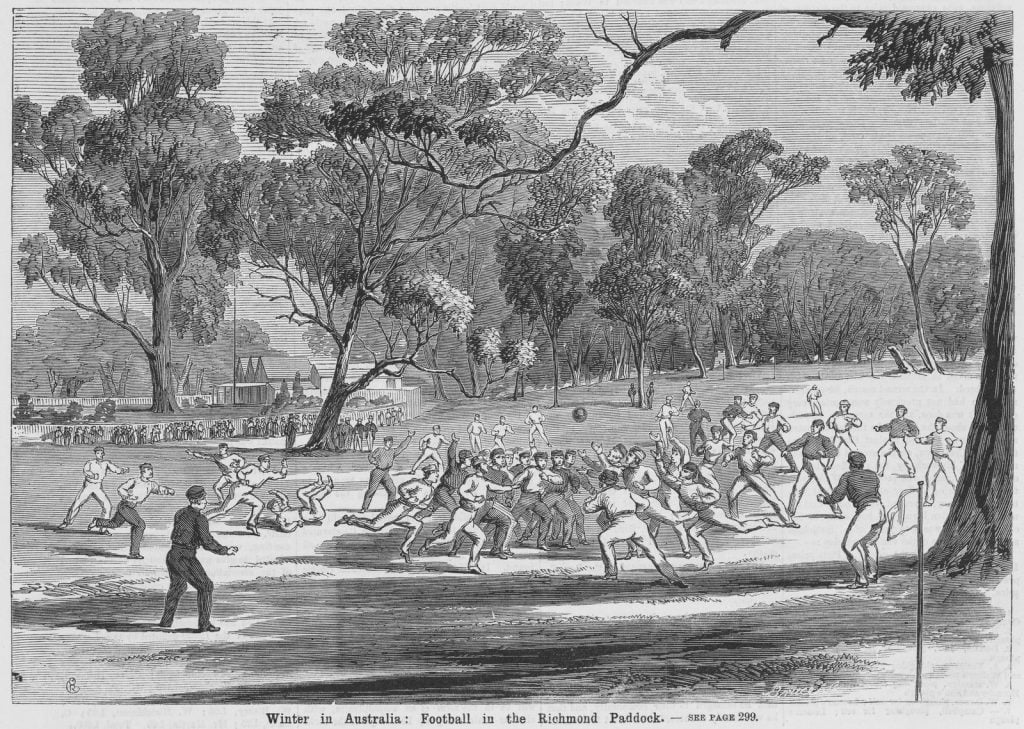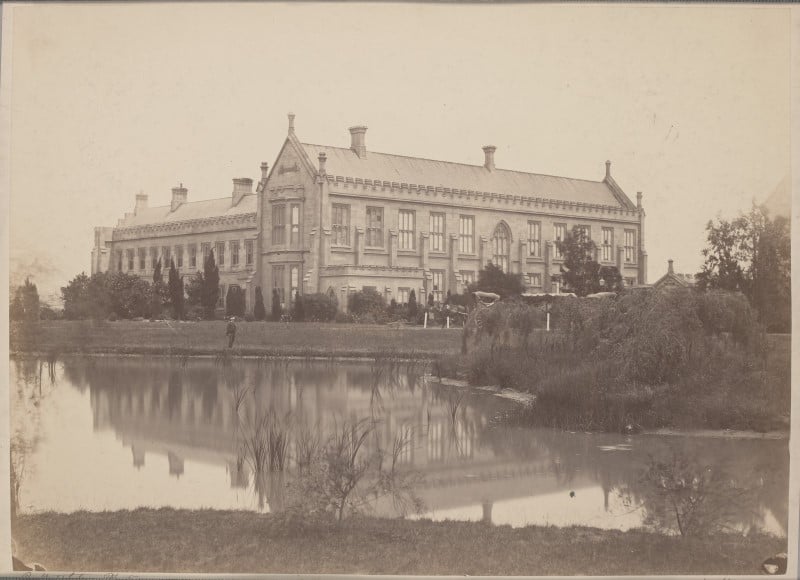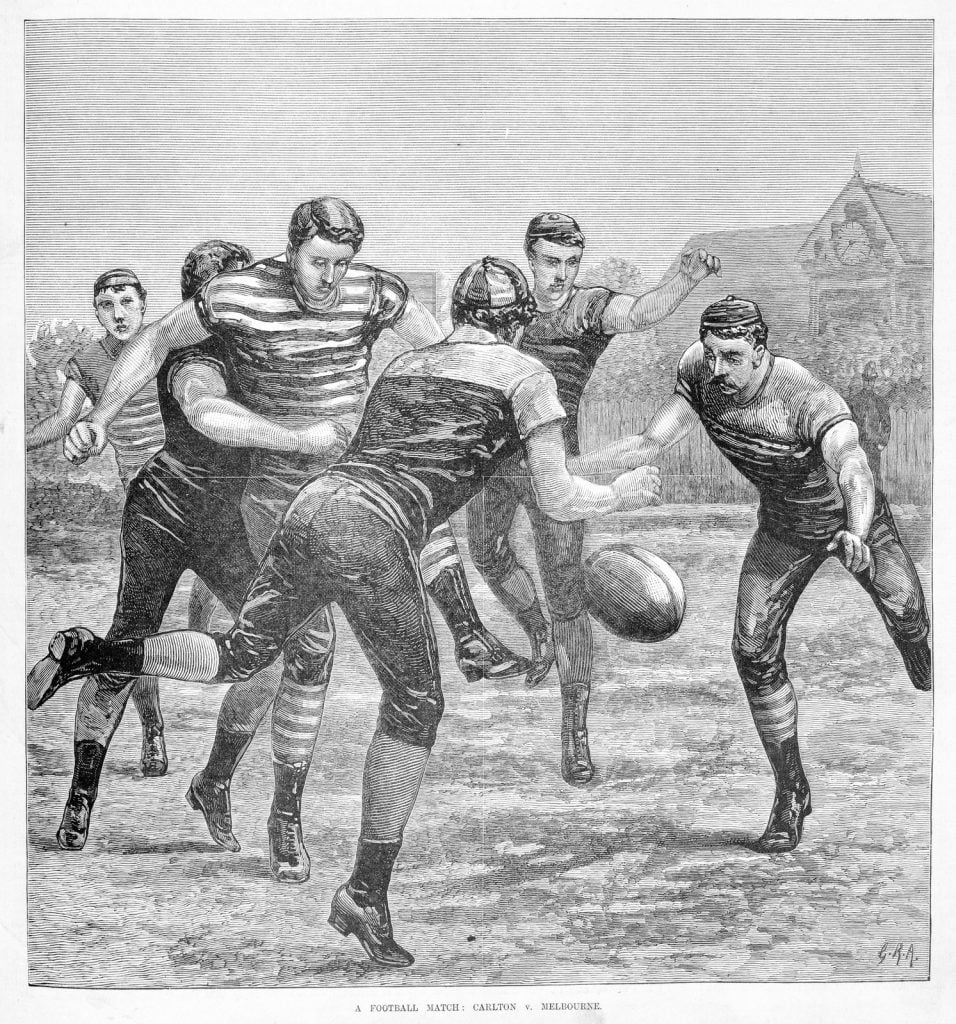As we enter AFL Grand Final week it is a good opportunity to look at a key moment in the game’s development.
Beginnings
Football began being played in Melbourne in 1858, initially as a way for cricketers to get “the muscles in full vigour during the winter months”. 1
What is considered to be the first organised match took place between Scotch College and Melbourne Grammar, commencing on 6 August 1858, and being completed over three afternoons. The game was not without controversy as the Melbourne Grammar Secretary took umbrage at suggestions that his school had failed to attend the second afternoon of the match.
The game finally ended in a draw, a month after it commenced. Within a few weeks a bard with Punch was moved to poetry in describing a visit to the football:
Upon the crowded car he jumped, / And squeezed as tight as barrelled haddock / Was driven to the Richmond paddock… / How there did fifty gallant men / Their hopes and passions altogether / Concentre in a lump of leather. 2
In May 1859, Melbourne Football Club first codified the rules, refining them further in July 1859.

Football in Richmond Paddock, 1866; IMP27/07/66/304
The early Australian Rules clubs were amongst the first of any football code in the world. As an example Melbourne (1858); Geelong (1859); Carlton (1864) and Essendon (1873) were all established before some of the most famous soccer clubs – Manchester United (1878); Liverpool (1892); AC Milan (1899); Real Madrid (1902). 3
Teams played wherever there was open ground. The playing area was rectangular, and the games were torrid affairs looking much more like rugby than the Australian football we know today.
Football developed from a rugby scrum to the long kick and high mark, as illustrated in the images above. (Drag the slider to compare the images).
Left: Australasian Sketcher with Pen and Pencil, 12 June 1875 p 41. See also A/S12/06/75/41.
Right: Football on the MCC ground “Goal” 1881, IAN27/07/81/132. See also Illustrated Australian News, 27 July 1881 p 132
An admission charge
An important step in the game’s evolution was moving from rectangular spaces marked on rough parkland to fenced cricket ovals with more consistent playing surfaces and accommodation for significant paying crowds.
Perhaps a catalyst for this change was the Carlton Football Club. As with many teams the Blues didn’t have a permanent ground until finally established at Princes Park in 1897.
In amongst this very peripatetic existence was a short period where they found a home at Melbourne University on land now occupied by Newman College. This land had been set aside for the Roman Catholic College (which wasn’t opened until 1918). The ground was known as the Madeline Street Reserve and the football club spent a significant sum on levelling and fencing which they hoped to recoup by charging admission.
There had previously been the occasional match with an entrance fee for one-off charitable causes but this was the first time that an entrance fee became standard and despite the 6d charge 6,000 spectators turned up for Carlton’s first game against Melbourne. It seemed that the club would recoup the £293 they had spent on the ground very quickly.
University of Melbourne, ca1880. Photo by Charles Nettleton; H16923
Unfortunately, the Melbourne University Council, presided over by Redmond Barry, decided that Carlton could not keep using the ground if they charged an entrance fee. In June 1877 both Carlton and the newly formed Victorian Football Association pleaded with the University Council to change their mind.
Council member George Rusden said the council “have sympathy with the love of athletic sports but the land in question cannot with propriety be used in the manner requested.”
Dr Bromby moved an amendment that “should the authorities who manage the Roman Catholic Ground see fit to grant permission for football the Council will offer no opposition so long as the games are conducted in an orderly manner.”
Despite the very sensible support of Dr Mackay, Dr Motherwell and Professor Irving, Dr Bromby inexplicably voted to defeat his own amendment. 4
Carlton continued to play home games at Madeline Street 5 but were no longer able to charge entry. In 1878 they went back to Royal Park with a considerable debt thanks to the parsimonious views of several of the University Council. The Leader newspaper was suitably unimpressed:
The refusal of the council, therefore, appears to be utterly ungracious and unreasonable, and one which will certainly not commend itself to the large body of the public who support football, and who showed their appreciation of the first enclosed ground used for the game, which this was, by flocking to it in thousands. 6
There’s money to be made
As the Leader noted, the Madeline Street experiment had shown that football supporters would turn up in great numbers regardless of an admission fee. No doubt cricket clubs, who up to that point left their splendid ovals vacant in the off season, saw an opportunity to share in the revenue of the winter game.
A football match: Carlton v. Melbourne, 1881; A/S18/06/81/193
In 1878 the Melbourne, South Melbourne and East Melbourne cricket grounds all became homes for football. As the East Melbourne Cricket Club noted:
The fitness of the ground was also demonstrated by the numbers who attended the football matches, especially that between Melbourne and Carlton. Those matches had greatly augmented the funds of the club, and would in future years be a regular source of income to the club.
Australian football evolved rapidly and it is hard to isolate all that was involved in the improvement of the game. But that short time the Carlton Football Club played at the Madeline Street Reserve at Melbourne University was where the earning power of the game was best demonstrated, precipitating a move from rectangles marked on unfenced parks, to fenced cricket ovals.
Sketch at the football match, Carlton v. Geelong. George Coulthard outpaces his Geelong opponent; APW24/07/80/49
By the late 1870s, football matches were being played on well-maintained, fenced cricket ovals that charged admission fees and accommodated larger crowds. This generated funds to further develop clubs and attract more players. The ovals tapered play towards the goals and the game became much more high scoring; essentially evolving into the game we see today. 7
See also
Australian Rules football research guide State Library Victoria
References
- Football Bell’s Life in Victoria and Sporting Chronicle 31 July 1858 p.3. See also Tom Wills letter Winter practice Bell’s Life in Victoria and Sporting Chronicle 10 July 1858 p.3
- Football, Melbourne Punch, 30 September 1858, p 7
- There were a number of other clubs established very early as well.
- University of Melbourne Council Minutes, Vol 4, 5 February 1877 – 21 December 1880. Meeting 18 June 1877 University of Melbourne Archives UM174
- now Swanston Street
- The Carlton Football Reserve, Leader 23 June 1877, p 12
- The ovals didn’t really add to the playing area – The Footballer identified rectangular grounds as 200 yards long and 150 yards wide while the MCG is 190 yards long and 160 yards wide at the wings. But the oval shape naturally funnelled the ball towards goal and scoring did increase significantly. While there were anomalies in the numbers of games played, across the 1876 and 1877 seasons 269 goals were scored, while over 1878 and 1879, 435 goals were scored. See Origins of Australian football : Victoria’s early history by Mark Pennings for details of matches over this period





Wonderful article, Andrew. Good to see that the Mighty Blues were footy innovators way back in the 1870s.
Actually, the first letter calling for a winter football club to prevent the cricketers from becoming stout was published in Bell’s Life on 10 July (also under Pedestrianism). The author was TW Wills. He was one of the four original signatories to the first set of rules drawn up on the back of an envelope in the Parade. Unfortunately all four of his grandparents were convicts so he was never quite accepted.
Interesting. Thanks for posting Sue. I have made a note to research this
Carlton only wanted to collect money to recoup the money club members had spent on improving the Madeline St. Ground.
Any extra was to be donated to the Melbourne Hospital. Carlton wanted a game to set a side each year for the purpose of raising funds for charity.
After Carlton was “turfed” off the ground, the game of Hurling was played on it and patrons were charged for admission!
They rivalry between Melbourne and Carlton was so intense that they played each other four times per season during the 1870s. These games fired the imagination,
drew the crowds and put Australian Football on a firm footing.
Without the advent of the Blues, the Australian game which by the mid 1860s was at a low ebb, may have withered and died.
Tom Wills had witnessed the aftermath of the massacre of friends and his family in Queensland. He had been away that day at a nearby farm. He turned to drink and committed suicide some years later. Wills had played cricket for Melbourne and Victoria, so I don’t think his convict ancestry affected him in that regard. Alcoholism and suicide would have been a social taboo.
Thanks Peter, very odd that Dr Bromby would vote against his own amendment. Still I think the games at Madeline Street proved the potential earning power of football. The blueseum is a fabulous resource.
in the The Argus July 7 1859 Page 4 and 5, it records a match between the South Yarra Club, was played amongst members of the M. F. C. in Richmond Paddock (http://trove.nla.gov.au/newspaper/article/5684038). 4 of my family member were in the South Yarra team of that day.
Henry Baker Chomley (1835-1914) – Bank manager/grazier
Arthur Wolfe Chomley (1837-1914) – judge
Charles Albert Chomley (1840-1862) – drowned in Switzerland
Thomas Alexander Brown(e) (1826-1915) aka Rolfe Bolderwood (Cousin in-law) – author/grazier
Wow, what an interesting connection. I didn’t realise Rolf Boldrewood was also a footballer
Thanks to Sue for mentioning Tom Wills’ role in the foundation of Aussie Rules. Suggest the link with the Aboriginal game Marn Grook should also be featured. I didn’t know all 4 of Tom Wills’ grandparents were convicts – that might have ben social death in marvellous Melbourne of the time. Great article 🙂
Thanks for the comments Nigel. The blog is primarily about charging for entry and the transition from rectangular playing areas to (cricket) ovals. But if you follow the See Also reference at the bottom of the blog you can see more history on our Australian Rules research guide . The links to William Blandowski’s observations and illustration of Marn Grook are of particular interest.
The Sheffield Football Club in England pre-dates Melbourne Rules, and was also formed to help cricketers retain fitness during the winter months. https://dorevillage.co.uk/pages/sheffield-where-football-began. Sound familiar?
Thanks Mike, yes Sheffield beat Melbourne Football Club by a year